The Paige typesetting machine should be remembered as a marvel of intricate mechanism and as an example of a complete non-casting type composing machine which worked. Instead, it will be remembered as the machine which "Mark Twain" lost a fortune on.
This present Notebook is for the most part a collection of literature available elsewhere. The only new item here is a scan of the largest of the 1895 Paige patents, done at 1200dpi from an original printed copy.
(This image is from Thompson's History of Composing Machines (1904), scanned at 1200 dpi from an original.)
Two Paige Compositors were built. One survives, the other is missing and is presumed to have been destroyed. The best research on the survival and destruction of these machines is that in Goble's 1985 paper "Mark Twain's Nemesis: The Paige Compositor" (see below) .
Goble reaches the following conclusions (documenting them well):
1. "The two machines themselves, together with their rights and patents, were bought for $20,000 in 1898 by ... Mergenthaler Linotype [Company]." (p. 22)
2. The earlier model, "shortly after the Mergenthaler Company acquired it, was presented to Cornell University." (p. 23)
3. "Correspondence in the Cornell archives indicates that this machine was returned to the Mergenthaler comapny in 1921 for placement in its museum in its Brooklyn, New York, headquarters." (p. 23)
4. This machine "was donated in 1957 to the Mark Twain Home at Hartford." (p. 23)
(This machine survives at the Mark Twain Home. See the Photographs section below for pictures of it.)
5. The second machine (the one used in the 1894 test of the Compositor) was "placed at Columbia University." (p. 24)
6. This machine is missing, but the nature of this is more complex than generally cited.
6a. Goble cite's Richard Huss' claim that it was scrapped during a Wourld War II scrap metal drive. This would appear to be confirmed by a letter to Goble from "a Columbia librarian [Alice Schreyer] indicat[ing] that a Paige Compositor had once been placed at the university, but that it had been discarded or scrapped." (pp. 24, 28).
6b. However, Goble also cites an assertion by Hellmut Lehmann-Haupt that in 1952 an "unassembled Paige composing machine" still existed at Columbia.
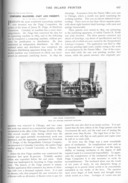
Thompson. (1903)
In installment no. 5 of his series "Composing Machines - Past and Present" in The Inland Printer. Vol. 30, No. 5 (February, 1903) John S. Thompson cover the Paige Compositor.
Here are the original 1200dpi page scans:
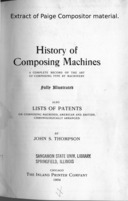
Thompson. (1904)
In 1904, Thompson reworked his Inland Printer series of articles into a book, a History of Composing Machines. (Chicago: The Inland Printer Co., 1904.) Here is an extract of the pages having to do with the Paige.
Here is a full-resolution (600dpi in this case) version of the image of the Paige on p. 24 of this book:
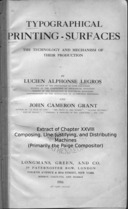
Legros & Grant. (1916)
Chapter 28, "Composing, Line-Justifying, and Distributing Machines." (London: Longmans, Green, and Co., 1916.) This chapter is concerned mostly with the Paige, and provides the most detailed technical account of it in the literature.
The icon at left links to a PDF of this chapter, extracted from my scan of the entire volume. For the whole volume, see: ../../../ Making Printing Matrices & Types -> Reprinted Literature -> General Literature: Legros & Grant
The PDF above contains the chapter and its illustrations at a useful but reduced resolution. Below are scans of the plates, separately. Click on each regular-sized image for the original 1200 dpi scan. (In each case I've edited the smaller version to look nice, but the larger version is just the original raw scan. You'll have to do your own image processing on them.)
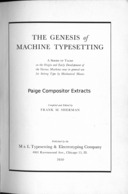
Sherman. (1950)
Sherman, Frank M. The Genesis of Machine Typesetting. (Chicago: M & L Typesetting & Electrotyping Company, 1950.) This book collects several essays on the subjet of machine typesetting; this present extract is from the essay by Sherman, "Early Inventions for Mechanical Typesetting."
Here are the two illustrations of the Paige from this book; click on either for a full-resolution version:
The book also contains a delightful still image from the 1944 film The Adventures of Mark Twain showing a quite fanciful interpretation of the Paige. It is a charming view of the Hollywood image of the mad inventor.

Goble. (1985)
Goble, Corban. "Mark Twain's Nemesis: The Paige Compositor." Paper presented to the History Division at the annual convention of the Association for Education in Journalism and Mass Communication, Memphis, TN, 1985-08. A detailed historical study of Paige and his machine.
The author has granted permission to the Educational Resources Information Center (ERIC) of the U.S. Department of Eductation to reprint this paper. It may be viewed online on their website, at http://www.eric.ed.gov/ERICWebPortal/detail?accno=ED265544

Hopkins. (2000)
Hopkins, Richard L. "A First-Hand View of the Paige Compositor." American Typecasting Fellowship Newsletter. No. 26 (November, 2000): 33-34, 47. Interesting account of a field trip to visit the one surviving machine at the Samuel Clemens house in Hartford, CT. Hopkins makes the interesting observation that they keyboard height of the Paige is appropriate for a standing, not a seated, compositor.

Photographs
Photographs of the Paige, other than those published in the sources above.
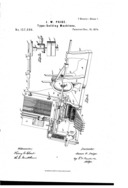
US Patent 157,694
US patent 157,694, issued 1874-12-15 to James W. Paige. "Improvement in Type-Setting Machines." Application filed 1872-08-13 (no application serial number given). At a mere 59 pages, including drawings, this patent is really quite brief when compared to 547,860.
This is a PDF assembled from PNG conversions of the TIFF page scans from the US Patent and Trademark Office. These scans were done at 300dpi bi-level (not greyscale) and are quite poor. Nevertheless, since the USPTO has deliberately destroyed the originals of all historic patents after this inadequate scanning, it is, now, the only official version.

US Patent 547,859
US patent 547,859, issued 1895-10-15 to James William Paige. "Machine for Setting, Distributing, and Justifying Type." Application filed 1882-12-05 as application serial number 78,527.
This is a PDF assembled from PNG conversions of the TIFF page scans from the US Patent and Trademark Office. These scans were done at 300dpi bi-level (not greyscale) and are quite poor (for the reasons noted above).
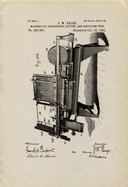
US Patent 547,860
This is the big one. US patent 547,860, issued 1895-10-15 to James William Paige. "Machine for Distributing, Setting, and Justifying Type." Application filed 1887-08-19 as application serial number 247,325.
This is a reasonably high-resolution scan (1200 dpi RGB) done by me from an original printed copy. Thanks are due to to Mark Knudsen for making this material available. This scan is of significance because, as noted above, the original was deliberately destroyed by the US Patent Office.

US Patent 547,861
US patent 547,861, issued 1895-10-15 to James William Paige and "Machine for Setting, Distributing, and Justifying Type." Application filed as application serial number
This is a PDF assembled from PNG conversions of the TIFF page scans from the US Patent and Trademark Office. These scans were done at 300dpi bi-level (not greyscale) and are quite poor (for the reasons noted above).
All of the material by Thompson is in the public domain due to the failure to renew copyright (as was then required) and, in any case, the expiration of all possible copyright. The scans and reprints here remain in the public domain.
The Genesis of Machine Typesetting (Sherman, 1950) was published without copyright notice at a time when such notice was required to secure copyright. It therefore passed into the public domain upon initial publication. The extracts reprinted from it here remain in the public domain.
Legros & Grant's Typographical Printing Surfaces is in the public domain in the United States due to the expiration of all possible US copyright. The reprints from it here are published in the US, and remain in the public domain in the US. However, note that it is possible that this text may be in copyright in the UK; whether it is or not depends upon the date of death of Grant, which has not been determined.
US patent specifications and drawings are in the public domain. The scans and reprints here remain in the public domain.
All portions of this document not noted otherwise are Copyright © 2011, 2014 by David M. MacMillan and Rollande Krandall.
Circuitous Root is a Registered Trademark of David M. MacMillan and Rollande Krandall.
This work is licensed under the Creative Commons "Attribution - ShareAlike" license. See http://creativecommons.org/licenses/by-sa/3.0/ for its terms.
Presented originally by Circuitous Root®
Select Resolution: 0 [other resolutions temporarily disabled due to lack of disk space]